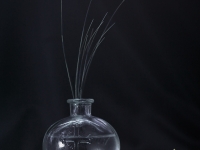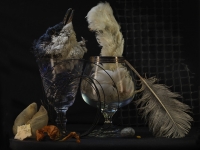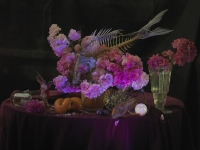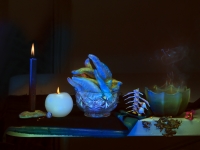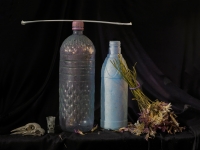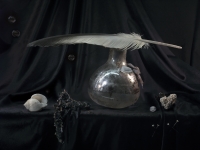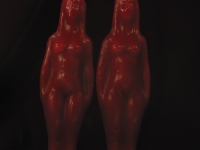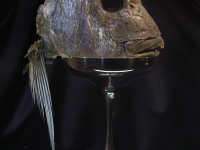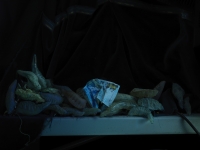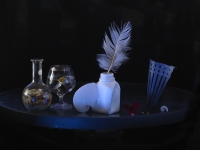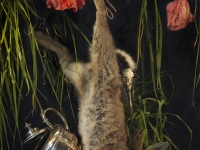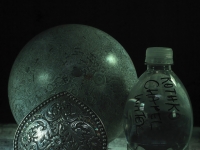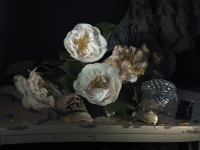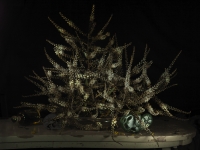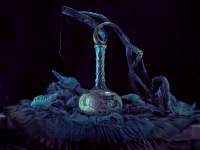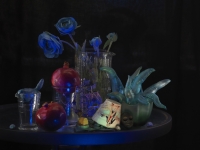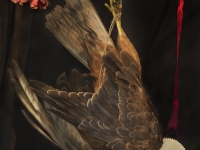 Back to Index
Back to Index
FIONA PARDINGTON — Ex Vivo

|
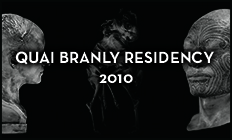
|
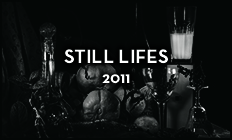
|
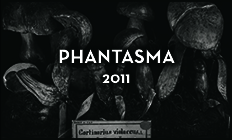
|
Ex Vivo
Old ocean, there is nothing far-fetched in the idea that you hide within your breast things which will in the future be useful to man. You have already given him the whale. You do not easily allow the greedy eyes of the natural sciences to guess the thousand secrets of your inmost organization. You are modest. Man brags incessantly of trifles. I hail you, old ocean.
— Comte de Lautreamont (Isidore-Lucien Ducasse), Les Chants de Maldoror (1869)
Time in the sea eats its tail, thrives, casts these
Indigestibles, the spars of purposes
That failed far from the surface. None grow rich
In the sea. This curved jawbone did not laugh
But gripped, gripped and is now a cenotaph.
— Ted Hughes, “Relic”
Twice a day the tides that lave and redraft the coastline wash up a diversity of bounty:driftwood, kelp, shells, dead crabs, bones, fishing floats, perhaps a rare paper nautilus,and occasional hints of life in the deep interior depths and cool green hells, or over the blue horizon. After a big storm, more than likely there will be dead seagulls and albatrosses too, studies in greyscale. New Zealand’s long and supine coastline acts like a driftnet, gathering it all up. You never know what gifts Tangaroa will surprise you with, which is part of the magic of it all. If it floats, and falls into the Tasman, the Pacific, the freezing Southern Ocean, or perhaps further afield, hidden currents will probably wash it up on our sand or shingle for a beachcomber to find.
It is beachcombing which provided most of the objets trouvés for this suite of works by Fiona Pardington. Appropriately enough, it starts out as a Pacific phenomenon. The first appearance of the word in print is to be found in Herman Melville’s 1847 novel Omoo which described a community of feckless and outcast Europeans in the Islands who had abandoned Western culture for a life “combing” the beach for anything they could use or trade. Not for the faint of heart, Sappho warns the squeamish against poking the coastal rubble; Μὴ κίνη χέραδασ. While living in Waiheke Island, Fiona regularly explored Rock Bay and Ontetangi beaches, and later Ripiro and Bayley’s Beach, walking her canine menagerie. She, also, was looking for things to use and trade, though these transactions are of an entirely aesthetic sort. She is, as Shakespeare writes of Autolycus in The Winter’s Tale, “a snapper-up of unconsidered trifles”
The albatross feathers allude to the artist’s great love of nature and her Ngāi Tahu, Kati Mamoe and Ngāti Kahungunu ancestry – Māori associations with the deep water, long voyages and return. To Māori, albatrosses, Torora, represented beauty, grace and power, and their feathers and bone were worn by people of rank or adorned the prow of waka taua (war canoes). The (with a nod to Monty Python) ex-gulls. Karoro, the blackbacked gull, were kept as pets by some Māori to control vermin, and were considered an ill omen seen inland. The objects that look like white wax flowers and the plastic casings of fired rifle cartridges. These can be considered symbols of explosive and potentially dangerous energy and transformation.
The philosophy of collecting and salvage moves like an eel up the river from the coast. Like the carnage from the Māori legend of the battle between the sea birds and the land birds, among the fallen, mingling with the gulls and albatrosses are a humdrum sparrow and a young kāhu (hawk). Te kāhu i runga whakaaorangi ana e rā, / Te pērā koia tōku rite, inawa ē! (“The hawk up above moves like clouds in the sky. Let me do the same!”). Here, too, are items that have washed up from the human sea; a crystal ball, a pounamu heart (the heart of Fiona’s whakapapa lies among the iwi of Te Wai Pounamu, the South Island), a hag stone (a stone naturally pierced by water through which those gifted with second sight were, according to legend, supposed to see the future and the other world through, a pewter mug, roses, and a cut glass decanter of water from Lake Wakatipu. Transparent and fragile vessels are important in Fiona’s work, alluding to the tradition of Vanitas painting (remember, you too shall one day die) and often containing water from places significant to the artist. These lustrous objects also reveal Fiona’s virtuosity with light, and photography, after all, is Classical Greek for drawing or writing with light. The eye scavenges.
— Andrew Paul Wood (2014)


